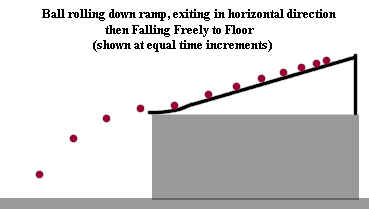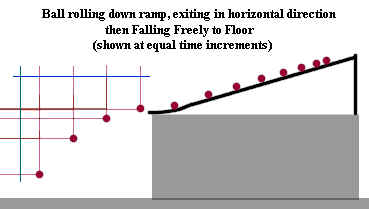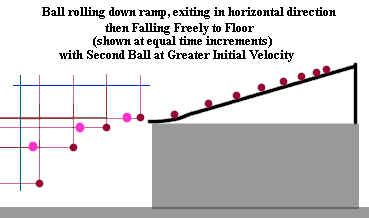The figure below shows a ball rolling down a ramp then falling to the floor. The
position of the ball is given at regular time intervals.
- While on the ramp the ball travels further during each time interval than during the
preceding time interval. This is due to the constant net force acting on the ball as
it travels down the incline.
- After leaving the ramp the ball is subjected to a net force equal to the gravitational
force, which acts in the vertical direction. This vertical net force accelerated the
ball in the downward direction, so the distance fallen in the vertical direction is
greater with each succeeding time interval.
- Between the ramp and the floor there is no force in the horizontal direction (for now we
regard the force of air resistance to be negligible) so the horizontal velocity of the
ball doesn't change. Thus the horizontal displacement of the ball is the same for
every time interval.

The same situation is depicted in the next picture, but vertical and horizontal
projection lines have been added so we can track the motion of the falling object in both
directions.
- The horizontal positions are tracked by the vertical projection lines as they cross the
horizontal blue line, which represents the x axis.
- We see that the intervals between horizontal positions are uniform, indicating the
unchanging velocity in the horizontal direction.
- Another way of saying the same thing is that the x coordinate of the object's position
changes by the same amount in equal time intervals, indicating constant velocity in the x
direction.
- The vertical positions are tracked by the horizontal projection lines as they cross the
vertical blue line, which represents the y axis.
- We see that the intervals between vertical positions increase with every time interval,
indicating the changing velocity in the vertical direction.
- We say that the y position of the object changes by increasing amounts with every time
interval, indicating a nonzero acceleration in the y direction.

The figure below shows the same ball as in the previous figures, plus a second
(slightly larger) ball. The second ball might have rolled down a ramp, or it might have
been shot from an air gun, or it might have been started off by some other means, but at
the instant the first ball was leaving the ramp moving for an instant solely in the
horizontal direction the second ball was right next to it and also moving in the
horizontal direction.
The only difference in the motion of the two balls is that the second ball has a
greater velocity in the horizontal direction than the first.
- At the end of every time interval the second ball has moved in the horizonal direction
about 1.7 times as far as the first, indicating that its horizontal velocity is about 1.7
times that of the first.
- The vertical position of the second ball is however always identical to that of the
first. This is because the vertical position of both balls is the result of zero
initial vertical velocity (both balls were initially moving only in the horizontal
direction) and the same acceleration resulting from the Earth's gravity.




